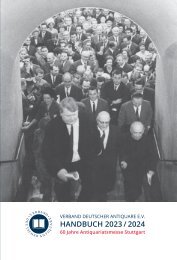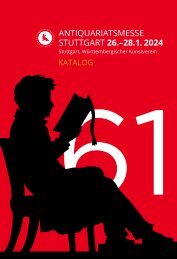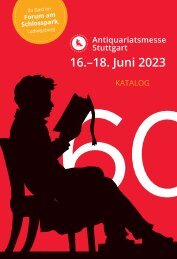Antiquariatsmesse Stuttgart 2022 - Katalog
Katalog zur Antiquariatsmesse Stuttgart 2022: Die diesjährige Antiquariatsmesse Stuttgart, Deutschlands bedeutendste Messe für schöne und seltene Bücher, Autographen, illustrierte Werke und Graphik findet, wie bereits im vergangenen Jahr pandemiebedingt nicht als klassische Messe, sondern in Form des gedruckten Kataloges und als digitale Messe auf bewährter Plattform (18. bis 22. Februar 2022) statt. 73 Antiquariate und Galerien aus Deutschland, Österreich und der Schweiz, den Niederlanden, Frankreich, England und den USA werden auch in diesem Jahr die gesamte Bandbreite des Antiquariatshandels präsentieren. Der gedruckte Katalog wird ab dem 31. Januar 2022 an interessierte Kunden verschickt, die virtuelle Messe öffnet ihre „digitalen Pforten“ am 18. Februar 2022 um 12.00 Uhr unter www.antiquariatsmesse-stuttgart.de
Katalog zur Antiquariatsmesse Stuttgart 2022: Die diesjährige Antiquariatsmesse Stuttgart, Deutschlands bedeutendste Messe für schöne und seltene Bücher, Autographen, illustrierte Werke und Graphik findet, wie bereits im vergangenen Jahr pandemiebedingt nicht als klassische Messe, sondern in Form des gedruckten Kataloges und als digitale Messe auf bewährter Plattform (18. bis 22. Februar 2022) statt.
73 Antiquariate und Galerien aus Deutschland, Österreich und der Schweiz, den Niederlanden, Frankreich, England und den USA werden auch in diesem Jahr die gesamte Bandbreite des Antiquariatshandels präsentieren.
Der gedruckte Katalog wird ab dem 31. Januar 2022 an interessierte Kunden verschickt, die virtuelle Messe öffnet ihre „digitalen Pforten“ am 18. Februar 2022 um 12.00 Uhr unter www.antiquariatsmesse-stuttgart.de
Erfolgreiche ePaper selbst erstellen
Machen Sie aus Ihren PDF Publikationen ein blätterbares Flipbook mit unserer einzigartigen Google optimierten e-Paper Software.
Mann contributed for the auction the original manuscript<br />
of his lecture on “Richard Wagner and the Nibelungen<br />
Ring”, writing in his foreword “It gives me<br />
pleasure to be able to send this contribution for this<br />
good and noble cause”.<br />
Albert Einstein, also like Mann a refugee from Nazi<br />
Germany, and who campaigned tirelessly for the rights<br />
of the refugees, contributes the preface and also donated<br />
a 3,000-word manuscript on anti-Semitism for<br />
the auction.<br />
The true first discovery of greenhouse gases by<br />
the “First Lady of Climate Science”<br />
Foote, Eunice Newton. Circumstances affecting<br />
the Heat of the Sun’s Rays. 1856. € 14 500,–<br />
Octavo. Uncut in original buff printed paper wrappers.<br />
Three engraved plates; folding world map; numerous illustrations,<br />
diagrams, and tables to text. Wrappers darkened,<br />
loss to spine panel affecting head and obscuring<br />
part of journal title, rear wrapper starting at joints with<br />
some small vertical markings across panel and a few<br />
chips at extremities, lower corner clipped; internally<br />
markedly crisp and clean with occasional faint marginal<br />
foxing. Overall a very good, unrestored copy.<br />
Uncommon first edition, in the original wrappers, of<br />
the first paper to record the discovery of the absorption<br />
of thermal radiation by carbon dioxide and water<br />
vapour, “a cornerstone of our current understanding<br />
of the greenhouse effect, climate change, weather and<br />
meteorology” (Jackson).<br />
The significance of Eunice Newton Foote (1819–1888)<br />
and her experiments with carbon dioxide (“carbonic<br />
acid gas”) has come to light in the last ten years or<br />
so, resulting in her being recognized as a key figure<br />
in climate science history. A 19th-century American<br />
scientist, inventor, and women’s rights campaigner, she<br />
was the first to demonstrate, in the present 1856 paper,<br />
that carbon dioxide and water vapour absorb heat. She<br />
also speculated that variations in carbon dioxide and<br />
water vapour in the atmosphere cause changes in climate.<br />
Foote’s findings were presented to the American<br />
Association for the Advancement of Science (AAAS)<br />
in August 1856, though she herself did not read the<br />
paper; it was given on her behalf by Joseph Henry, then<br />
the founding director of the Smithsonian. This is the<br />
UCSB-Perlin copy.<br />
Freud proofreads his final published work<br />
Freud, Sigmund. Signed photograph. [London:<br />
Wilhelm Hoffer, photographer, 1938]. Original silver<br />
gelatine print (112 × 87 mm). Signed by the subject,<br />
“Sigm. Freud”, across the lighter portion of the<br />
photograph. Pencil markings on verso and faint ink<br />
processing number “89 030”; traces of album mount.<br />
Silvering of the darker parts of the image, else very<br />
good. Presented in a dark stained oak frame with<br />
museum acrylic glazing. € 27 000,–<br />
A superb signed photograph of Freud at work taken<br />
by the Austrian-British psychoanalyst Wilhelm Hoffer<br />
(1897–1967), depicting Freud seated at his desk in<br />
London, reading the manuscript of Moses and Monotheism.<br />
Freud had begun working on his Moses book in 1934<br />
and partly published it in German in 1937. He arrived<br />
in London on 6 June 1938, announcing that he wished<br />
to continue his biblical studies. (Hoffer also fled Vienna<br />
for London at about the same time.) Freud finished the<br />
book that year and the complete German text in three<br />
parts was first published in Amsterdam in March 1939<br />
as “Der Mann Moses und die Monotheistische Religion”.<br />
Freud’s English was excellent, but he entrusted<br />
the task of translating the book to Katerina (Kitty) Jokl,<br />
who had been at school with Freud’s daughter, Anna.<br />
The English translation was published by the Hogarth<br />
Press in May 1939, Freud dying in September that year.<br />
John Law and the Mississippi Company<br />
Law, John – Anon. Curieuse Anmerckungen über<br />
den Staat von Franckreich. Leipzig: in der Missisippischen<br />
Staats-Druckerey, 1720. € 13 500,–<br />
Octavo (163 × 100 mm). Bound with another work<br />
in contemporary speckled paste paper boards, paper<br />
spine label lettered in manuscript. Engraved portrait<br />
frontispiece of John Law. Spine ends, joints, and corners<br />
rubbed, with some flaking of sprinkled paper covering,<br />
paper stock lightly browned with occasional spotting;<br />
a very good copy.<br />
Rare first edition of this anonymous account of the rise<br />
and decline of France under Louis XIV, who “under the<br />
clever guidance of Mr. Law has to the amazement of all<br />
fortunately improved it” (our translation). Dedicated to<br />
“Mons. Law”, who “der Welt bey anderthalb Jahren<br />
so viel zu reden gemacht [hat]”, the stubbornly anonymous<br />
author (he signs himself so) also describes the<br />
state of France following Louis XIV’s death, its subsequent<br />
recovery under the Prince Regent, and an account<br />
of Law’s activities and the Mississippi Company.<br />
Bound after this work is a copy of the life of Cardinal<br />
Giulio Alberoni, prime minister of Anjou, a German<br />
translation apparently from the Italian, published in<br />
1718. The work is attributed in WorldCat to Jean<br />
Rousset de Missy.<br />
Alden 720/58; Goldsmiths’ 5608; Kress 3185; Sabin<br />
39308.<br />
81






